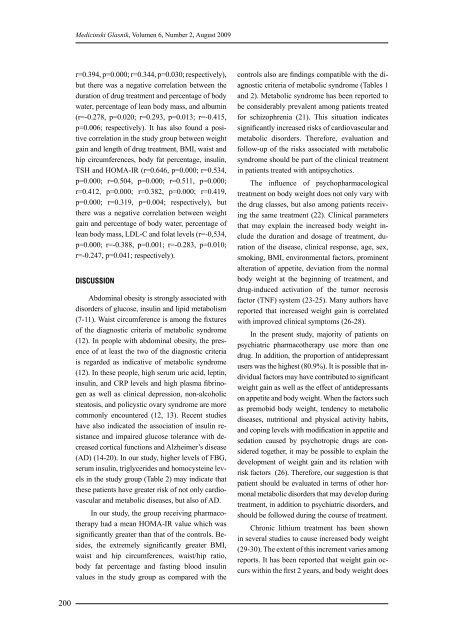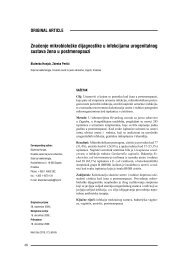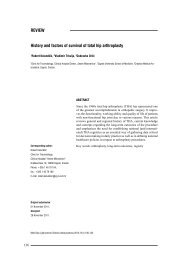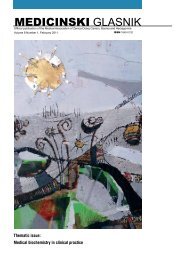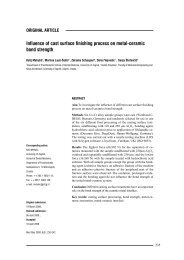MEDICINSKI GLASNIK
MEDICINSKI GLASNIK
MEDICINSKI GLASNIK
Create successful ePaper yourself
Turn your PDF publications into a flip-book with our unique Google optimized e-Paper software.
200<br />
Medicinski Glasnik, Volumen 6, Number 2, August 2009<br />
r=0.394, p=0.000; r=0.344, p=0.030; respectively),<br />
but there was a negative correlation between the<br />
duration of drug treatment and percentage of body<br />
water, percentage of lean body mass, and albumin<br />
(r=-0.278, p=0.020; r=0.293, p=0.013; r=-0.415,<br />
p=0.006; respectively). It has also found a positive<br />
correlation in the study group between weight<br />
gain and length of drug treatment, BMI, waist and<br />
hip circumferences, body fat percentage, insulin,<br />
TSH and HOMA-IR (r=0.646, p=0.000; r=0.534,<br />
p=0.000; r=0.504, p=0.000; r=0.511, p=0.000;<br />
r=0.412, p=0.000; r=0.382, p=0.000; r=0.419,<br />
p=0.000; r=0.319, p=0.004; respectively), but<br />
there was a negative correlation between weight<br />
gain and percentage of body water, percentage of<br />
lean body mass, LDL-C and folat levels (r=-0,534,<br />
p=0.000; r=-0.388, p=0.001; r=-0.283, p=0.010;<br />
r=-0.247, p=0.041; respectively).<br />
DISCUSSION<br />
Abdominal obesity is strongly associated with<br />
disorders of glucose, insulin and lipid metabolism<br />
(7-11). Waist circumference is among the fixtures<br />
of the diagnostic criteria of metabolic syndrome<br />
(12). In people with abdominal obesity, the presence<br />
of at least the two of the diagnostic criteria<br />
is regarded as indicative of metabolic syndrome<br />
(12). In these people, high serum uric acid, leptin,<br />
insulin, and CRP levels and high plasma fibrinogen<br />
as well as clinical depression, non-alcoholic<br />
steatosis, and policystic ovary syndrome are more<br />
commonly encountered (12, 13). Recent studies<br />
have also indicated the association of insulin resistance<br />
and impaired glucose tolerance with decreased<br />
cortical functions and Alzheimer’s disease<br />
(AD) (14-20). In our study, higher levels of FBG,<br />
serum insulin, triglycerides and homocysteine levels<br />
in the study group (Table 2) may indicate that<br />
these patients have greater risk of not only cardiovascular<br />
and metabolic diseases, but also of AD.<br />
In our study, the group receiving pharmacotherapy<br />
had a mean HOMA-IR value which was<br />
significantly greater than that of the controls. Besides,<br />
the extremely significantly greater BMI,<br />
waist and hip circumferences, waist/hip ratio,<br />
body fat percentage and fasting blood insulin<br />
values in the study group as compared with the<br />
controls also are findings compatible with the diagnostic<br />
criteria of metabolic syndrome (Tables 1<br />
and 2). Metabolic syndrome has been reported to<br />
be considerably prevalent among patients treated<br />
for schizophrenia (21). This situation indicates<br />
significantly increased risks of cardiovascular and<br />
metabolic disorders. Therefore, evaluation and<br />
follow-up of the risks associated with metabolic<br />
syndrome should be part of the clinical treatment<br />
in patients treated with antipsychotics.<br />
The influence of psychopharmacological<br />
treatment on body weight does not only vary with<br />
the drug classes, but also among patients receiving<br />
the same treatment (22). Clinical parameters<br />
that may explain the increased body weight include<br />
the duration and dosage of treatment, duration<br />
of the disease, clinical response, age, sex,<br />
smoking, BMI, environmental factors, prominent<br />
alteration of appetite, deviation from the normal<br />
body weight at the beginning of treatment, and<br />
drug-induced activation of the tumor necrosis<br />
factor (TNF) system (23-25). Many authors have<br />
reported that increased weight gain is correlated<br />
with improved clinical symptoms (26-28).<br />
In the present study, majority of patients on<br />
psychiatric pharmacotherapy use more than one<br />
drug. In addition, the proportion of antidepressant<br />
users was the highest (80.9%). It is possible that individual<br />
factors may have contributed to significant<br />
weight gain as well as the effect of antidepressants<br />
on appetite and body weight. When the factors such<br />
as premobid body weight, tendency to metabolic<br />
diseases, nutritional and physical activity habits,<br />
and coping levels with modification in appetite and<br />
sedation caused by psychotropic drugs are considered<br />
together, it may be possible to explain the<br />
development of weight gain and its relation with<br />
risk factors (26). Therefore, our suggestion is that<br />
patient should be evaluated in terms of other hormonal<br />
metabolic disorders that may develop during<br />
treatment, in addition to psychiatric disorders, and<br />
should be followed during the course of treatment.<br />
Chronic lithium treatment has been shown<br />
in several studies to cause increased body weight<br />
(29-30). The extent of this increment varies among<br />
reports. It has been reported that weight gain occurs<br />
within the first 2 years, and body weight does


